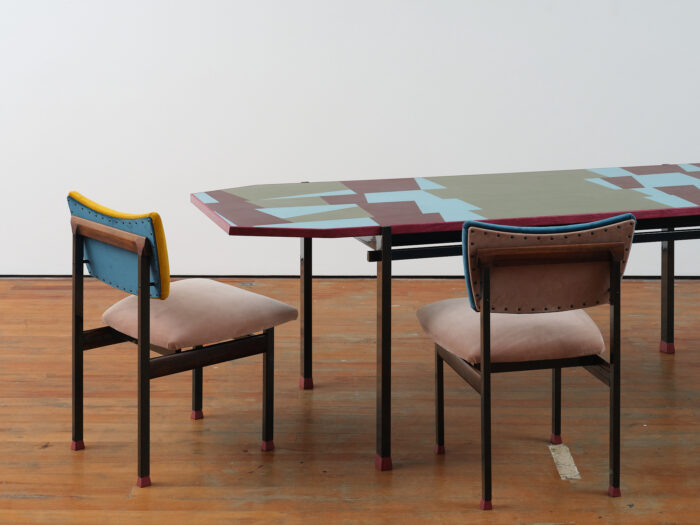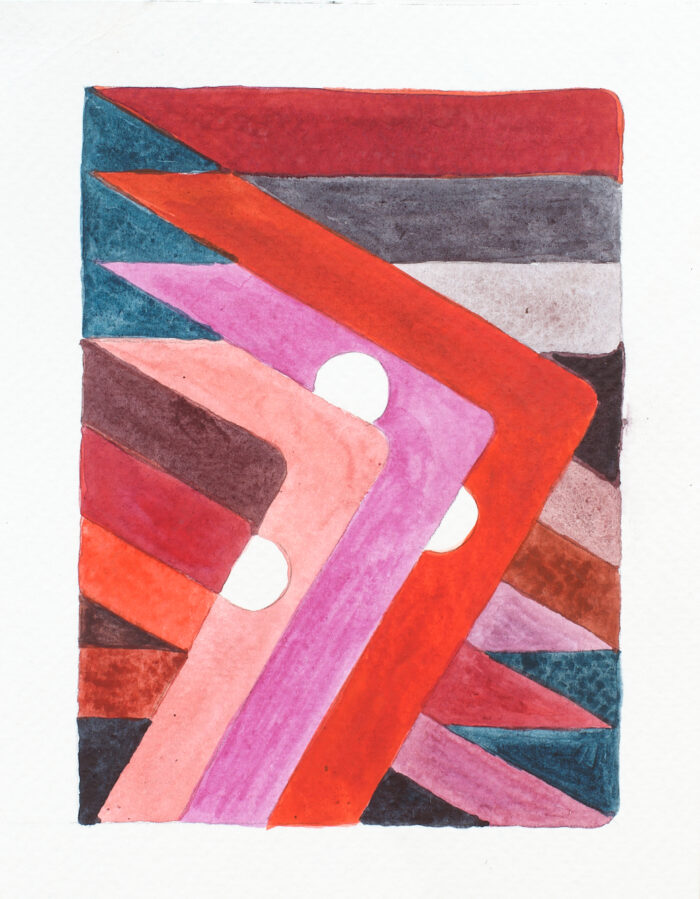
Michael Lett is pleased to present works of significance by Michael Parekōwhai. Cast in monumental bronze, these works operate as object lessons in both stability and the transitory, who is firmly in place and what has the ability to move around. Whereas the artist’s life-size, sculpted figure is a masterful yet playful demonstration of authority and strength; Parekōwhai’s rendered trees and objects point towards a temporary rootlessness together with the apparatus required to enjoy safe passage from one place to another.

Michael Parekōwhai
Kapa Haka
2008
Bronze
1820 x 600 x 450mm
AP 1/1 (From an edition of 3)
Michael Parekōwhai’s Kapa Haka consists of a figure of a security guard cast in patinated bronze. A formidable presence, the life-size figure adopts a strong stance, with folded arms he calmly surveys his surroundings. Firmly rooted to the ground, Parekōwhai’s uniformed guard emanates authority and power, even access, with a swipe-card dangling at his hip.
This bronze iteration harks back to a crowd of fifteen fibreglass examples previously exhibited for one night, twenty years ago, at the original Michael Lett premises on Karangahape Road.


Parekōwhai’s lone figure takes its title from words used to describe Māori performing arts, specifically those involving groups standing in formation and performing dances accompanied by words chanted or sung. The title echoes the artist’s ongoing concern with performance, particularly musical instruments such as the pianos in On First Looking Towards Chapman’s Homer at the 2011 Venice Biennale and his Ten Guitars (1999); as well as his various performing seals and elephants, and the ballerinas of Song of the Frog (2005).
An intriguing aspect of Kapa Haka is that its meaning alters according to where it is placed. Each time the figure is placed in a different situation the question of what is being guarded or surveyed shifts too.

Michael Parekōwhai
The Moment of Cubism and Nude Descending a Staircase
2009
hand-finished bronze, patina
1365 x 880 x 1175mm
Unique
Parekōwhai’s The Moment of Cubism / Nude Descending a Staircase consists of sculpted lemon trees and a pallet made of patinated bronze.
The saplings appear to be freshly purchased from a nursery, their roots still wrapped in plastic. What is their significance? For an extended period of time the lemon tree had a special place in the hearts of the inhabitants of Aotearoa New Zealand. For many, planting a lemon tree was one of the first things done after purchasing a new home. The citrus together with a feijoa tree, rhubarb patch and rotary clothesline were ubiquitous to the typical New Zealand backyard. Therefore the lemon tree has a connection to Parekōwhai’s The Lighthouse, a public commission from 2017 involving a 1950s New Zealand family home, perched on the end of Queens Wharf.

Supporting the two trees is what appears to be a wooden pallet. Such objects play crucial roles in international shipping, logistics and storage, they enable the safe movement of units from one place to another. Sturdy and ubiquitous, this mundane, modular and repeatable object is co-opted by Parekōwhai and used as a mode of display.
The work shares its title with an art historical essay from the 1960s and a painting from the 1910s. Parekōwhai cleverly supersedes the art of painting, for though cubist painting concerned itself with capturing objects from multiple perspectives, this objective is easily achieved by visitors who can simply move around the artist’s sculpted forms.


As is always the case with work by Parekōwhai the meaning of this sculpture cannot be fixed or pinned-down. Ever playful, it operates in a slippery and ambiguous zone, it is a puzzle or conundrum that can never be solved. The sculpted elements are made monumental, cast in bronze they become divorced or separated from their usual material realities so that they can endure through time.


Michael Parekowhai (Ngāriki Rotoawe, Ngāti Whakarongo, b. 1968) draws upon an abundant range of both vernacular and collective vocabularies in his work. He re-manufactures these lexicons into complex narrative structures and formal languages, exploring perceptions of space, the ambiguities of identity, the shifting sensitivities of historical memory and the fluid relationship between art and craft. Ideas of camaraderie, tools of teaching and childhood learning, as well as quotes from modern art history and popular culture, also play out in many of Parekōwhai’s stories. While his work is often described as emphasising the extraordinariness of the ordinary, each body of work has layers of potential for meaning and significance—they are open to any depth of interpretation and storytelling.
Parekōwhai was selected to represent New Zealand at the 54th Venice Biennale in 2011 where he exhibited On First Looking into Chapman’s Homer at the New Zealand pavilion. In 2015 he exhibited The Promised Land, a retrospective survey of his practice at the Queensland Art Gallery | Gallery of Modern Art, Brisbane. In 2018, Te Papa Tongarewa opened its newly expanded contemporary art galleries with Détour, a major solo exhibition from Parekōwhai.
His work has been included in: Te Hau Whakatonu | A Series of Never-Ending Beginnings, Govett-Brewster Art Gallery, New Plymouth (2023-2024); Dreamhome: Stories of Art and Shelter, Art Gallery of New South Wales (2022-2023); Toi Tu Toi Ora: Contemporary Māori Art, Auckland Art Gallery Toi o Tāmaki (2020); the 5th Asia Pacific Triennial of Contemporary Art, Queensland Art Gallery | Gallery of Modern Art, Brisbane (2006); the 5th Gwangju Biennale (2004); the 13th Biennale of Sydney (2002) and Headlands: Thinking Through New Zealand Art, Museum of Contemporary Art Australia, Sydney (1992).
Parekōwhai graduated with a Bachelor of Fine Arts from Elam School of Fine Arts, Auckland in 1990, followed by a Master of Fine Arts in 2000. In 2011 he was awarded the Arts Foundation of New Zealand Laureate award.


